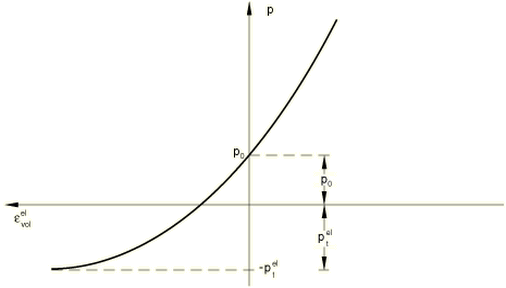Elastic behavior of porous materials | ||||||||||
|
| |||||||||
ProductsAbaqus/StandardAbaqus/CAE
Logarithmic porous elasticity model
The logarithmic porous elasticity model is valid for small elastic strains (normally less than 5%). It is a nonlinear, isotropic elasticity model in which the pressure stress varies as an exponential function of volumetric strain. The model allows a zero or nonzero elastic tensile stress limit.
Defining the volumetric behavior
Often, the elastic part of the volumetric behavior of porous materials is modeled accurately by assuming that the elastic part of the change in volume of the material is proportional to the logarithm of the pressure stress (Figure 1):
where is the “logarithmic bulk modulus”; is the initial void ratio; p is the equivalent pressure stress, defined by
is the initial value of the equivalent pressure stress; is the elastic part of the volume ratio between the current and reference configurations; and is the “elastic tensile strength” of the material (in the sense that as ).

Input File Usage
Use all three of the following options to define a porous elastic material:
POROUS ELASTIC, TYPE=LOGARITHMIC,SHEAR=G or POISSON to define and INITIAL CONDITIONS, TYPE=STRESS to define INITIAL CONDITIONS, TYPE=RATIO to define
Abaqus/CAE Usage
Use all three of the following options to define a porous elastic material:
Property module: material editor: : Type: Logarithmic
Load module: Create Predefined Field: Step: Initial: choose Mechanical for the Category and Stress for the Types for Selected Step
Load module: Create Predefined Field: Step: Initial: choose Other for the Category and Void ratio for the Types for Selected Step
Defining the shear behavior
The deviatoric elastic behavior of a porous material can be defined in either of two ways.
By defining the shear modulus
Give the shear modulus, G. The deviatoric stress, , is then related to the deviatoric part of the total elastic strain, , by
In this case the shear behavior is not affected by compaction of the material.
Input File Usage
POROUS ELASTIC, TYPE=LOGARITHMIC,SHEAR=G
Abaqus/CAE Usage
Property module: material editor: : Type: Logarithmic: Shear: G
By defining Poisson's ratio
Define Poisson's ratio, . The instantaneous shear modulus is then defined from the instantaneous bulk modulus and Poisson's ratio as
where is the logarithmic measure of the elastic volume change. In this case
Thus, the elastic shear stiffness increases as the material is compacted. This equation is integrated to give the total stress–total elastic strain relationship.
Input File Usage
POROUS ELASTIC, TYPE=LOGARITHMIC, SHEAR=POISSON
Abaqus/CAE Usage
Property module: material editor: : Type: Logarithmic: Shear: Poisson
![]()
Power law–based porous elasticity model
In the case of the power law–based porous elasticity model, Young's modulus is related to the pressure by a power law:
where is the reference Young's modulus at pressure , and and are material constants. is used to define the elastic modulus for tensile effective pressure and is calculated as follows:
Poisson's ratio is an exponential function of pressure
where is the value of the Poisson's ratio corresponding to the limit , is the value of the Poisson's ratio at , and is a material constant.
![]()
Material options
The porous elasticity models can be used by themselves or in combination with other material options.
The logarithmic porous elasticity model can be combined with:
-
isotropic expansion to introduce thermal volume changes (Thermal expansion).
The power law–based porous elasticity model can be combined with:
-
the soft rock plasticity model; or
-
isotropic expansion to introduce thermal volume changes (Thermal expansion).
It is not possible to use porous elasticity with rate-dependent plasticity or viscoelasticity.
Porous elasticity cannot be used with the porous metal plasticity model (Porous metal plasticity).
See Combining material behaviors for more details.
![]()
Elements
Porous elasticity cannot be used with hybrid elements or plane stress elements (including shells and membranes), but it can be used with any other pure stress/displacement element in Abaqus/Standard.
If used with reduced-integration elements with total-stiffness hourglass control, Abaqus/Standard cannot calculate a default value for the hourglass stiffness of the element if the logarithmic porous elasticity model is used and the shear behavior is defined through Poisson's ratio. Hence, you must specify the hourglass stiffness. See Section controls for details.
If fluid pore pressure is important (such as in undrained soils), stress/displacement elements that include pore pressure can be used.